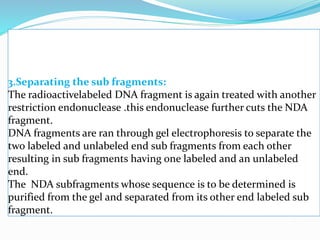DND sequencing
- 2. Definition: Sequencing DNA means determining the order of the four chemical building blocks called "bases" ,that make up the DNA molecule. In the DNA double helix, the four chemical bases always bond with the same partner to form "base pairs.“ These bases are Adenine, Cytosine, Thymine, Guanine. Adenine (A) always pairs with thymine (T); cytosine (C) always pairs with guanine (G). The sequence tells scientists the kind of genetic information that is carried in a particular DNA segment.
- 3. Methods: Basic Methods: 1.maxam/gilbert chemical sequencing. 2.sanger chain termination method. Advanced methods: 1.short gun sequencing. 2.bridge PCR Sequencing. Next generation methods: 1.polony sequence. 2.pyrosequencing. 3.solid sequencing. 4.illumini sequencing etc.
- 4. Basic DNA sequencing methods Chemical Sequencing: 1: Purifying the sequence: Enzyme restriction, endonuclease is used and DNA is cut at a specific sequence. 2. Addition of radioactive phosphate: Since DNA has sugar phosphate backbone ,phosphate present at the 3’ end of the cleaved DNA segment will be removed and replaced by radioactive phosphate (32p). Phosphatase is the enzyme used for phosphate cleavage while kinase is the enzyme used for radioactive phosphate addition.
- 5. 3.Separating the sub fragments: The radioactivelabeled DNA fragment is again treated with another restriction endonuclease .this endonuclease further cuts the NDA fragment. DNA fragments are ran through gel electrophoresis to separate the two labeled and unlabeled end sub fragments from each other resulting in sub fragments having one labeled and an unlabeled end. The NDA subfragments whose sequence is to be determined is purified from the gel and separated from its other end labeled sub fragment.
- 6. 4. Identifying the bases: four base specific chemical samples are produce. 1. Greaction,(dimethyl sulphate methylates (DMS)Guanine). 2. C reaction 3. A reaction with some G cleavage (DMS also methylates Adenine but does not result in strand cleavage. 4. T reaction with some C cleavage. Each reaction solution only treats a particular base.
- 7. 5. Cleaving the DNA: when the bases are removed from each particular base removing reaction the NDA strands are subjected to another reagent . This reagent breaks the NDA at very particular points from where the bases have been removed. This results in NDA strands of different lenghts. 6.reading the sequence: Electrophoresis is performed again on the four reaction sample. Each reaction is ran on its own lane and arranged according to its length. Autoradiography: A technique that reads radioactive molecules on an x-ray film is used to detect the separated NDA fragments. Thus the sequence is read from bottom to top.
- 9. Chain Termination Sequencing: The most popular method is dideoxy method or Sanger method. Named after its inventor, Frederick Sanger, who was awarded the 1980 Nobel prize in chemistry for this achievment. This sequencing method is based on the use of chain terminators, the dideoxynucleotides (ddNTPs). The dideoxynucleotides, or ddNTPSs, differ from deoxynucleotides by the lack of a free 3' OH group on the five- carbon sugar. If a ddNTP is added to a growing DNA strand, the chain is not extended any further because the free 3' OH group needed to add another nucleotide is not available. By using a predetermined ratio of deoxyribonucleotides to dideoxynucleotides, it is possible to generate DNA fragments of different sizes when replicating DNA in vitro.
- 10. A Sanger sequencing reaction is just a modified in vitro DNA replication reaction. As such the following components are needed: template DNA (which will the be DNA whose sequence will be determined), DNA Polymerase to catalyze the replication reactions, a primer that basepairs prior to the portion of the DNA you want to sequence, dNTPs, and ddNTPs. Most of the time in a Sanger sequencing reaction, DNA Polymerase will add a proper dNTP to the growing strand it is synthesizing in vitro. But at random locations, it will instead add a ddNTP. When it does, that strand will be terminated at the ddNTP just added. If enough template DNAs are included in the reaction mix, each one will have the ddNTP inserted at a different random location, and there will be at least one DNA terminated at each different nucleotide along its length for as long as the in vitro reaction can take place (about 900 nucleotides under optimal conditions.
- 11. The ddNTPs which terminate the strands have fluorescent labels covalently attached to them. Each of the four ddNTPs carries a different label, so each different ddNTP will fluoresce a different color. After the reaction is over, the reaction is subject to capillary electrophoresis. All the newly synthesized fragments, each terminated at a different nucleotide and so each a different length, are separated by size. As each differently-sized fragment exits the capillary column, a laser excites the flourescent tag on its terminal nucleotide. From the color of the resulting flouresence, a computer can keep track of which nucleotide was present as the terminating nucleotide. The computer also keeps track of the order in which the terminating nucleotides appeared, which is the sequence of the DNA used in the original reaction.
- 12. First step: First many copies of NDA fragment are needed to be made. To do this, scientist use the polymerase chain reaction that heats and cools dna to make quick copies of the fragment. Next step: Fragments are heated again to be unwound into single stranded DNA. Then a primer is added which binds with NDA. ddNTPs are added.
- 13. Final step: The DNA strand is run through gel electrophoresis which sorts the fragments by size.














